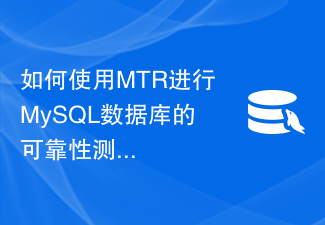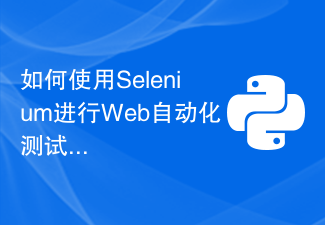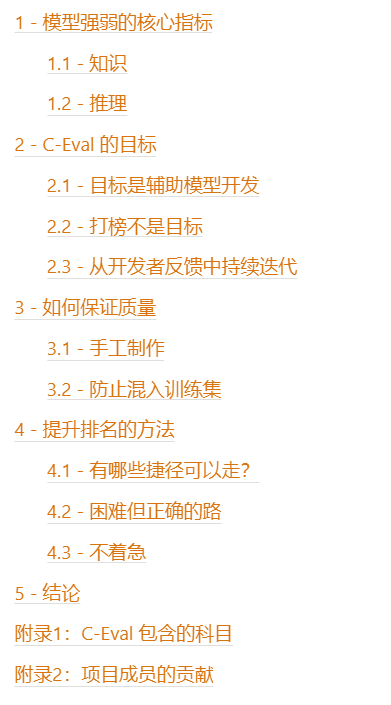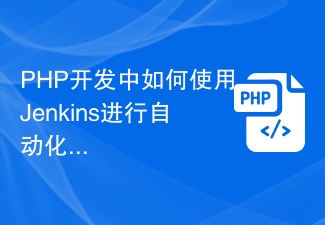In Go applications, testing and coverage practices are critical, including implementing unit tests, using mocks and stubs, setting up assertions, and using multiple coverage tools. By following best practices and integrating them into your continuous integration pipeline, you can improve code quality, stability, and coverage.

Go Framework Testing and Coverage Practices
In Go application development, testing and coverage are crucial to ensure code quality and stability. This article will introduce best practices for testing and coverage in the Go framework and provide practical examples.
Testing Framework
The Go language provides a built-in testing framework that makes it easy to write and run test cases. You can use the testing package to write test functions and the go test command to run the tests.
Example
import "testing"
func TestSum(t *testing.T) {
if sum(2, 3) != 5 {
t.Error("Sum(2, 3) should be 5")
}
}
func sum(a, b int) int {
return a + b
}Coverage
Code coverage measures how well test cases execute the code base. In Go, you can use the go test -cover command to generate a coverage report. It will show the lines of code that are not covered and the coverage percentage.
Example
go test -cover
Best Practice
1. Writing unit tests
Unit tests focus on Test a single function or method. This helps isolate and test specific parts of the code.
2. Use mocks and stubs
Mocks and stubs can mock external dependencies, making tests more independent. This reduces coupling in tests and makes test maintenance easier.
3. Set assertion
Assertion checks the expected value of the test result. Use clear and meaningful assertion messages to help debug failing tests.
4. Use multiple coverage tools
go test -cover Provides basic coverage information. You can use other tools, such as gcov or goveralls, to get more detailed reports.
5. Continuous Integration
Integrate testing and coverage checks into your continuous integration (CI) pipeline. This will ensure errors are caught and improve coverage before the code is built and released.
Practical Case
Consider the following example, which calculates the sum of the squares of two numbers:
import "math"
func SquareSum(a, b float64) float64 {
return math.Pow(a, 2) + math.Pow(b, 2)
}We can test it using the following test code:
import (
"testing"
"math"
)
func TestSquareSum(t *testing.T) {
tests := []struct {
a, b float64
want float64
}{
{2, 3, 13},
{0, 5, 25},
}
for _, test := range tests {
got := SquareSum(test.a, test.b)
if !math.ApproxEqual(got, test.want) {
t.Errorf("SquareSum(%f, %f) = %f, want %f", test.a, test.b, got, test.want)
}
}
}Run the following command to generate a coverage report:
go test -cover
This command will generate a report similar to the following:
ok example.com/square 0.001s coverage: 100.0%
Indicates that the code is completely covered.
The above is the detailed content of golang framework testing and coverage practice. For more information, please follow other related articles on the PHP Chinese website!
 Golang中的数据库测试技巧Aug 10, 2023 pm 02:51 PM
Golang中的数据库测试技巧Aug 10, 2023 pm 02:51 PMGolang中的数据库测试技巧引言:在开发应用程序时,数据库测试是一个非常重要的环节。合适的测试方法可以帮助我们发现潜在的问题并确保数据库操作的正确性。本文将介绍Golang中的一些常用数据库测试技巧,并提供相应的代码示例。一、使用内存数据库进行测试在编写数据库相关的测试时,我们通常会面临一个问题:如何在不依赖外部数据库的情况下进行测试?这里我们可以使用内存
 如何使用MTR进行MySQL数据库的可靠性测试?Jul 13, 2023 pm 12:05 PM
如何使用MTR进行MySQL数据库的可靠性测试?Jul 13, 2023 pm 12:05 PM如何使用MTR进行MySQL数据库的可靠性测试?概述:MTR(MySQL测试运行器)是MySQL官方提供的一个测试工具,可以帮助开发人员进行MySQL数据库的功能和性能测试。在开发过程中,为了确保数据库的可靠性和稳定性,我们经常需要进行各种测试,而MTR提供了一种简单方便且可靠的方法来进行这些测试。步骤:安装MySQL测试运行器:首先,需要从MySQL官方网
 如何使用Selenium进行Web自动化测试Aug 02, 2023 pm 07:43 PM
如何使用Selenium进行Web自动化测试Aug 02, 2023 pm 07:43 PM如何使用Selenium进行Web自动化测试概述:Web自动化测试是现代软件开发过程中至关重要的一环。Selenium是一个强大的自动化测试工具,可以模拟用户在Web浏览器中的操作,实现自动化的测试流程。本文将介绍如何使用Selenium进行Web自动化测试,并附带代码示例,帮助读者快速上手。环境准备在开始之前,需要安装Selenium库和Web浏览器驱动程
 如何进行PHP单元测试?May 12, 2023 am 08:28 AM
如何进行PHP单元测试?May 12, 2023 am 08:28 AM在Web开发中,PHP是一种流行的语言,因此对于任何人来说,对PHP进行单元测试是一个必须掌握的技能。本文将介绍什么是PHP单元测试以及如何进行PHP单元测试。一、什么是PHP单元测试?PHP单元测试是指测试一个PHP应用程序的最小组成部分,也称为代码单元。这些代码单元可以是方法、类或一组类。PHP单元测试旨在确认每个代码单元都能按预期工作,并且能否正确地与
 13948道题目,涵盖微积分、线代等52个学科,上交清华给中文大模型做了个测试集May 25, 2023 pm 01:44 PM
13948道题目,涵盖微积分、线代等52个学科,上交清华给中文大模型做了个测试集May 25, 2023 pm 01:44 PMChatGPT的出现,使中文社区意识到与国际领先水平的差距。近期,中文大模型研发如火如荼,但中文评价基准却很少。在OpenAIGPT系列/GooglePaLM系列/DeepMindChinchilla系列/AnthropicClaude系列的研发过程中,MMLU/MATH/BBH这三个数据集发挥了至关重要的作用,因为它们比较全面地覆盖了模型各个维度的能力。最值得注意的是MMLU这个数据集,它考虑了57个学科,从人文到社科到理工多个大类的综合知识能力。DeepMind的Gopher和Chinchi
 PHP开发中如何使用Jenkins进行自动化测试Jun 27, 2023 pm 02:29 PM
PHP开发中如何使用Jenkins进行自动化测试Jun 27, 2023 pm 02:29 PM随着Web应用程序规模的不断扩大,PHP语言的应用也越来越广泛。在软件开发过程中,自动化测试可以大大提高开发效率和软件质量。而Jenkins是一个可扩展的开源自动化服务器,它能够自动执行软件构建、测试、部署等操作,今天我们来看一下在PHP开发中如何使用Jenkins进行自动化测试。一、Jenkins的安装和配置首先,我们需要在服务器上安
 PHP开发CMS系统完成后如何进行有效的测试Jun 21, 2023 am 10:58 AM
PHP开发CMS系统完成后如何进行有效的测试Jun 21, 2023 am 10:58 AM在日益发展的互联网时代中,CMS系统已经成为了网络建设中的一项重要工具。其中PHP语言开发的CMS系统因其简单易用,自由度高,成为了经典的CMS系统之一。然而,PHP开发CMS系统过程中的测试工作也是至关重要的。只有经过完善、系统的测试工作,我们才可以保证开发出的CMS系统在使用中更加稳定、可靠。那么,如何进行有效的PHP开发CMS系统测试呢?一、测试流程的
 测试MySQL连接的高并发性能应如何在命令行进行?Jun 30, 2023 pm 07:25 PM
测试MySQL连接的高并发性能应如何在命令行进行?Jun 30, 2023 pm 07:25 PM如何在命令行中测试MySQL连接的高并发性能?随着互联网应用的不断普及,数据库的高并发性能成为了很多需求的关注点之一。而MySQL作为一个流行的开源数据库,其高并发性能也是被广泛关注的。在测试MySQL连接的高并发性能之前,我们需要先明确一些概念和准备工作:并发连接:指的是同时有多个客户端与数据库建立连接,并且这些连接同时进行数据库操作。连接数限制:MySQ


Hot AI Tools

Undresser.AI Undress
AI-powered app for creating realistic nude photos

AI Clothes Remover
Online AI tool for removing clothes from photos.

Undress AI Tool
Undress images for free

Clothoff.io
AI clothes remover

AI Hentai Generator
Generate AI Hentai for free.

Hot Article

Hot Tools

PhpStorm Mac version
The latest (2018.2.1) professional PHP integrated development tool

MantisBT
Mantis is an easy-to-deploy web-based defect tracking tool designed to aid in product defect tracking. It requires PHP, MySQL and a web server. Check out our demo and hosting services.

SublimeText3 Linux new version
SublimeText3 Linux latest version

SecLists
SecLists is the ultimate security tester's companion. It is a collection of various types of lists that are frequently used during security assessments, all in one place. SecLists helps make security testing more efficient and productive by conveniently providing all the lists a security tester might need. List types include usernames, passwords, URLs, fuzzing payloads, sensitive data patterns, web shells, and more. The tester can simply pull this repository onto a new test machine and he will have access to every type of list he needs.

EditPlus Chinese cracked version
Small size, syntax highlighting, does not support code prompt function







